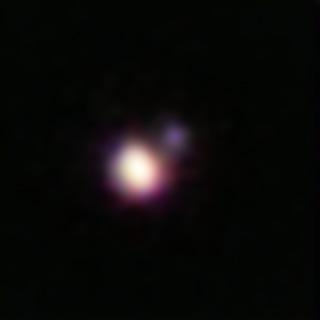Top Qs
Timeline
Chat
Perspective
CFBDSIR J145829+101343
Binary star system From Wikipedia, the free encyclopedia
Remove ads
CFBDSIR J145829+101343 (designation abbreviated to CFBDSIR 1458+10, or CFBDSIR J1458+1013) is a binary system of two brown dwarfs of spectral classes T9 + Y0 orbiting each other,[2] located in constellation Boötes about 104 light-years away from Earth.[4]
The smaller companion, CFBDSIR 1458+10B, has a surface temperature of approx 370 K (≈100 °C)[7][8]. It used to be known as the coolest known brown dwarf until the discovery of WISE 1828+2650 in August 2011.[9]
Remove ads
Discovery
Summarize
Perspective
CFBDSIR 1458+10 A was discovered in 2010 by Delorme et al. from the Canada-France Brown Dwarf Survey using the facilities MegaCam and WIRCam mounted on the 3.6 m Canada-France-Hawaii Telescope, located on Mauna Kea Observatory, Hawaii. Image in z` band was taken on 2004 July 15 with MegaCam, and image in J band was taken on 2007 April 1 with WIRCam. In 2009 they made follow-up photometry, using the SOFI near infrared camera at the ESO 3.5 m New Technology Telescope (NTT) at the La Silla Observatory, Chile. In 2010 Delorme et al. published a paper in Astronomy and Astrophysics where they reported the identification of 55 T-dwarfs candidates, six of which were photometrically confirmed as T-dwarfs, including 3 ultracool brown dwarfs (later than T7 dwarfs and possible Y dwarfs), including CFBDSIR 1458+10.[10][note 1]
Discovery of B
CFBDSIR 1458+10 B was discovered in 2011 by Liu et al. with laser guide star (LGS) adaptive optics (AO) system of the 10 m Keck II Telescope on Mauna Kea, Hawaii, using infra-red camera NIRC2 (the observations were made on 2010 May 22 and 2010 July 8 (UT)). In 2011 Liu et al. published a paper in The Astrophysical Journal where they presented discovery of CFBDSIR 1458+10 system component B (the only discovery presented in the article). Also they presented a near-infrared (J-band) trigonometric parallax of the system, measured using WIRCam on the Canada-France-Hawaii Telescope (CFHT), Mauna Kea, in seven epochs during the 2009–2010; and spectroscopy with the X-Shooter spectrograph at the European Southern Observatory's Very Large Telescope (VLT) Unit Telescope 2 (UT2) in Chile (the observations have been performed from May 5 to July 9, 2010), that allowed to calculate the temperature (and other physical parameters) of the two brown dwarfs.[7][5]
Remove ads
2012 Keck LGS-AO imaging
In 2012 CFBDSIR 1458+10 system was observed by Liu et al. with laser guide star (LGS) adaptive optics (AO) system of the 10 m Keck II Telescope on Mauna Kea, Hawaii, using infra-red camera NIRC2 (the observations were made on 2012 April 13 (UT)). In 2012 Liu et al. published a paper in The Astrophysical Journal where they presented results of observations with Keck II LGS-AO of three brown dwarf binary systems, binarity of the two of which was first presented in this paper, and binarity of the other one, CFBDSIR 1458+10, was known before.[2]
Remove ads
Distance
Trigonometric parallax of CFBDSIR 1458+10, measured under The Hawaii Infrared Parallax Program by Dupuy & Liu in 2012, is 31.3 ± 2.5 mas, corresponding to a distance 31.9+2.8
−2.4 pc, or 104.2+9.0
−7.7 ly.[4]
CFBDSIR 1458+10 distance estimates
Non-trigonometric distance estimates are marked in italic. The best estimate is marked in bold.
Space motion
CFBDSIR 1458+10 has proper motion of about 420 milliarcseconds per year.[4]
CFBDSIR 1458+10 proper motion estimates
The most accurate estimates are marked in bold.
Remove ads
Physical properties
Summarize
Perspective
Using three models, Liu et al. calculated physical properties of CFBDSIR 1458+10 components.[5]
From Lyon/COND models and Lbol:
From Burrows et al. (1997) models and Lbol):
From Burrows et al. (2003) models and M(J):
The adopted surface temperature of B is 370 ± 40 K, and adopted mass is 6-15 MJup.[5]
Luminosity
At the time of its discovery, CFBDSIR 1458+10 B was the least luminous brown dwarf known.[5]
CFBDSIR 1458+10 bolometric luminosity estimates
Remove ads
B's spectral class
In Liu et al. (2011) CFBDSIR 1458+10 B was assigned to the spectral class >T10,[5] it was proposed that CFBDSIR 1458+10 B may be a member of the Y spectral class of brown dwarfs.[10][5][12] In 2012 Liu et al. assigned it a spectral class Y0.[2]
Water clouds
Due to the low surface temperature for a brown dwarf, CFBDSIR 1458+10 B may be able to form water clouds in its upper atmosphere.[8]
See also
- WISE J0336−0143 – first Y + Y binary brown dwarf system discovered
The other two brown dwarf binary systems, observed by Liu et al. with Keck II LGS-AO in 2012:[2]
- WISE 1217+1626 (T9 + Y0, binarity was newly discovered)
- WISE 1711+3500 (T8 + T9.5, binarity was newly discovered)
Notes
- The other two ultracool brown dwarfs are CFBDSIR221903.07+002417.92 and CFBDSIR221505.06+003053.11. Three earlier type confirmed T dwarfs, as well as 49 unconfirmed candidates, are not listed in the article. (However, it is mentioned that two of three earlier type confirmed T dwarfs are re-identifications of already spectroscopically confirmed CFBDS brown dwarfs).
References
External links
Wikiwand - on
Seamless Wikipedia browsing. On steroids.
Remove ads

